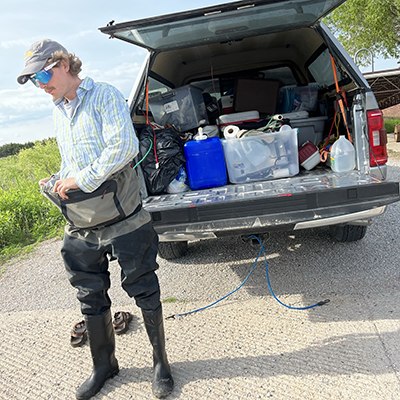
Daniel Gschwentner, a Doctorate of Philosophy candidate in Natural Resource Sciences with a specialization in Applied Ecology will present "Wildfire Effects on Primary Production and Lake Ice Dynamics in Sandhill Lakes" on September 29, 2023 at 3:00 pm in 107 South Hardin Hall. The seminar will also be streamed lived on line at https://go.unl.edu/viewsrnseminars
Daniel received his bachelor’s degree from Loughborough University, UK, where he was introduced to limnology and the study of lake sediments. At UNL, Daniel has studied the ecology and chemistry of alkaline and saline Sand Hill lakes in western Nebraska. His research focuses on the interactions between primary production, nutrient cycling and water chemistry in lake systems as well as lake response to environmental disturbances. Daniel is grateful to have received funding from the Daugherty Water For Food Institute, the USGS, and the NSF through the STOICH-project.
Abstract
Long ago, in a time forgotten, a wet climate threw the dunes of the Nebraska Sand Hills out of balance. Grasslands proliferated, stabilizing dune complexes as upwelling groundwater birthed a horde of shallow lakes. In a land where temperatures can exceed 100 Fahrenheit and plummet well-below freezing across the solstice seasons, change is afoot. The cold is returning, and in the frozen wastes of the Nebraska Sand Hills, ice is amassing across lakes. Yet, summer grassland wildfires abound initiating novel environmental circumstances for Sand Hill lakes. At the center of these events lies climate change, a disturbance as harsh and unyielding as the windswept and sun-bleached Sand Hills.
Sweeping from a harsh land of cold to a summertime of scorching heat, A Study of Ice and Fire tells a tale of lake ice cover, nitrogen, phosphorous and algae, who come together in the unrelenting maelstrom of biogeochemical cycles and environmental change. Here, groundwater inputs and evaporation form complex and nutrient-rich brines; seasonal and interannual variability carries limnologists off into madness; algal biomass proliferates; dissolved oxygen is consumed entirely under ice cover, ferrying fish beyond the Wall; wildfire ash blunts the advance of light into aquatic environments; nitrogen-limited lakes remain unspoiled by the hot tongue of fire; and lake ice cover waxes and wanes in accordance with atmospheric temperatures.
Amid sinking watercraft and labyrinths of undocumented R code, lab and field work, cruel budget cuts and victorious grant applications, committee meetings and conspiratorial coffee breaks, allies and crafty PhD supervisors, the story of the Sand Hill lakes unfolds, as intrepid students endeavor to survive that deadliest of conflicts: graduate school.
More details at: https://snr.unl.edu/aboutus/when/seminars.aspx